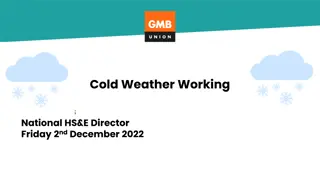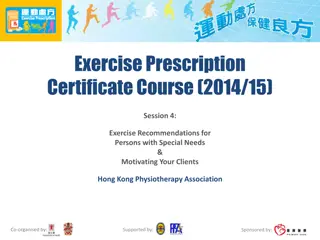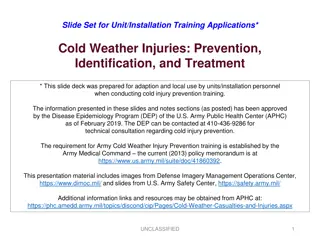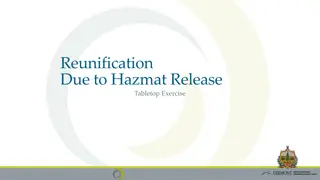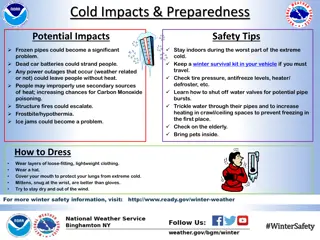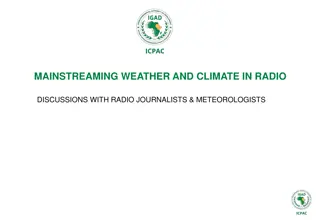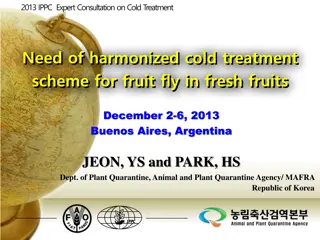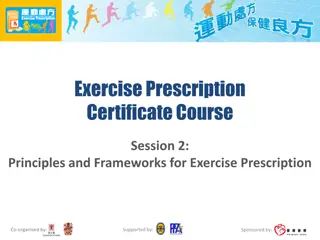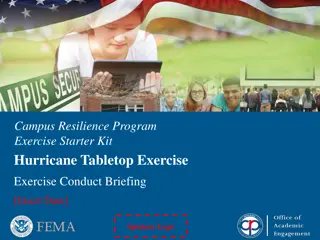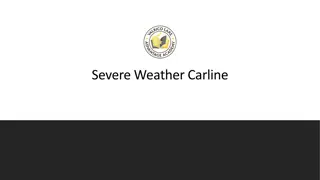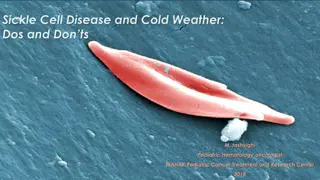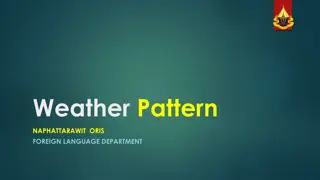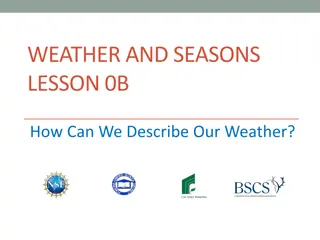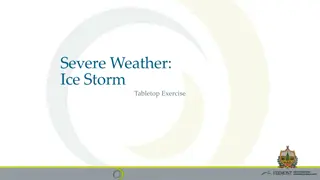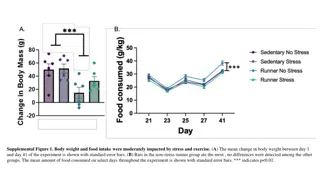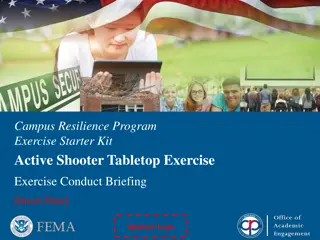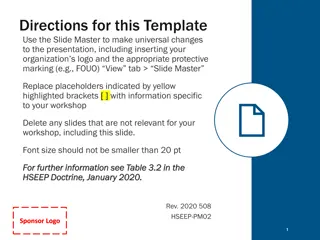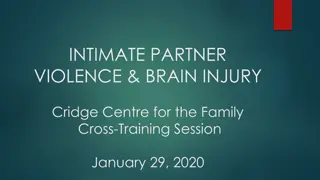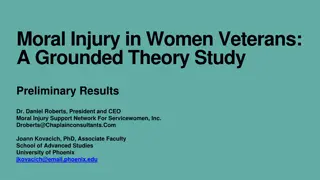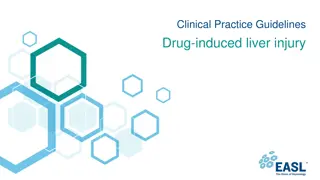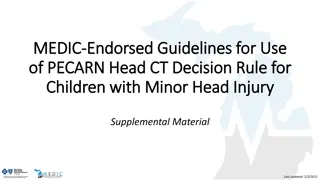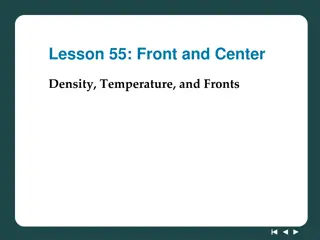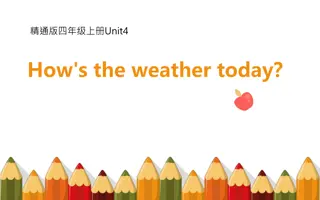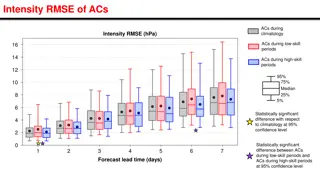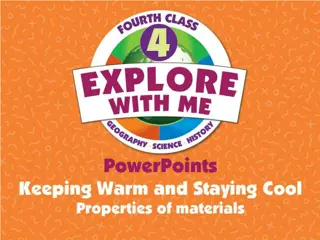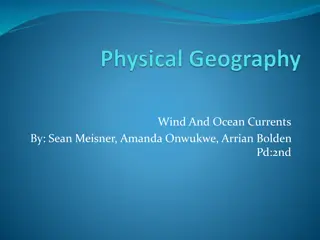Cold Weather Exercise Injury Prevention and Treatment Guidelines
This expert consensus statement by the ACSM provides comprehensive information on preventing and treating cold injuries during exercise. It covers frostbite, hypothermia, snow blindness, and other cold-related conditions, emphasizing the importance of understanding risk factors, prevention strategies, and proper treatment. The statement outlines classification systems for frostbite severity, prevention measures such as wind chill index utilization, and treatment guidelines including avoiding re-exposure and addressing concurrent conditions like hypothermia.
Download Presentation

Please find below an Image/Link to download the presentation.
The content on the website is provided AS IS for your information and personal use only. It may not be sold, licensed, or shared on other websites without obtaining consent from the author. Download presentation by click this link. If you encounter any issues during the download, it is possible that the publisher has removed the file from their server.
E N D
Presentation Transcript
Injury Prevention and Exercise Injury Prevention and Exercise Performance during Cold Performance during Cold- -Weather Exercise Exercise Weather ACSM Expert Consensus Statement 2021 ACSM Expert Consensus Statement 2021
Writing Group John W. Castellani, PhD Clare M. Eglin, PhD Tiina M. Ikaheimo, PhD Hugh Montgomery, MD Peter Paal, MD Michael J. Tipton, PhD
Purpose of the Consensus Statement This statement updates and replaces the ACSM position statement from 2006 titled, Prevention of Cold Injuries during Exercise and addresses deleterious aspects of exposure to cold and reflects the College s position on the scientific and clinical aspects of cold injury during exercise. This Consensus Statement provides up-to-date information on the pathogenesis, nature, impacts, prevention and treatment of the most common cold injuries: frostbite, non freezing cold injury, hypothermia, avalanche burial, snow blindness, drowning, and sudden cardiac death. Cold injury can result from exercising at low temperatures, and can impair exercise performance, or cause lifelong debility or death. As many people work or exercise in or near cold environments (air or water), the challenges of the cold can impair performance or threaten life.
Frostbite Frostbite is a direct freezing injury commonly affecting poorly perfused exposed tissues. Climate, behavior, individual characteristics and physiology are all factors that may predispose frostbite or non freezing cold injury (Table 1)(8-11). In-field classification systems anddegree classifications: 1st, 2nd, 3rd and 4th range from superficial to deep structures such as muscle or bone (Table 2) (190). Prevention Exposure time for injury can vary from seconds to hours depending on the type and intensity. Using the wind chill index (WCT) is the primary strategy to reduce frostbite risk (Figure 1)(39). Additional frostbite injuries (contact cooling) can occur within seconds, and depends on surface temperature, type of material, contact duration, and several individual factors (43). Treatment Further cold exposure should be avoided. Place in a warm, dry environment and wet clothing should be removed(46-47). Consider treating concurrent conditions such as hypothermia (should be treated first), direct mechanical injuries, or refreezing possibility especially when considering thawing or rewarming.
Table 2. Traditional classification of frostbite adapted from Fudge (189). A simpler 2-tier classification may be more appropriate for field use (superficial no or minimal anticipated tissue loss, corresponding to 1st and 2nd degree injury: deep anticipated tissue loss, corresponding to 3rd and 4th -degree injury (190). 1st degree (superficial): numbness, central white or yellow, waxy discoloration, surrounded by erythema and edema, desquamation, dysesthesia 2nd degree (superficial): surface blisters containing clear or opalescent fluid surrounded by erythema and edema 3rd degree (full dermal thickness): may initially present as 2nd degree, but hemorrhagic blisters appear within 24 hours, tissue loss involving entire thickness of skin 4th degree (deeper structures such as muscle and bone)
Figure 1. Wind Chill Temperature Index in F and C. Time is risk of cheek frostbite in the most susceptible 5 % of the population. From (38)
Non-Freezing cold injury (NFCI) NFCI results when exposure to cold and often cold-wet conditions cause tissues temperatures to fall below 15 C (59 F) for a prolonged period. The periphery (fingers, toes, nose, ears) are more commonly affected but unlike frostbite, the tissues do not freeze. The result is protracted intense vasoconstriction and associated ischemia and/or reperfusion cause neurovascular damage (48). Prevention The most commonly affected by NFCI are military or athletes such as ice skaters, cyclists, divers, and long distance power rowers. Hikers or mountaineers can also be affected, along with certain groups being more susceptible to NFCI (51- 56). Treatment Inter-individual NFCI susceptibility varies greatly, and risk mitigation necessitates an individual basis with anyone feeling cold or complaining of cold extremities being closely monitored or removed from cold-wet environments to prevent further cooling. Enable core warming if hypothermia is suspected (51-55). NFCI should focus on the keeping the body warm by remaining active. Appropriate clothing is essential, as is protection of the hands and feet (9,12).
Accidental Hypothermia A drop in deep body (core) temperature (Tdeep) to <35 C (95 F) (76,77) with the rate of cooling determined from clothing, environment, and exercise intensity. Primary and secondary accidental hypothermia result from environmental cold exposure, exhaustion, trauma, insufficient heating/insulation, individual characteristics and physiology in which body heat loss exceeds heat production(78). Hypothermia can range from mild to serve with a variety of common signs and symptoms (Table 3). Prevention Exercise induced heat production and appropriate clothing provide the greatest protection against hypothermia by reducing heat loss, providing insulation, and air trapping (85). Thermal models can predict the amount of clothing needed to maintain Tdeep and can combat problems such as overdressing to remain dry with excess heat production from exercise (76,77,92). Treatment For mild, moderate, or severe hypothermic individuals there are different treatments and strategies (In- hospital vs. Out-of-hospital) if Tdeep can not be assessed in the field (Figure 2). Without temperature measures, medical history and clinical findings should be used (Table 4-5) as hyperthermia stage/classification correlate with level of consciousness or the risk of afterdrop and hypothermic-induced cardiac arrest (77).
Avalanche Burial The risk for cold injuries increases for smaller people who lose heat more rapidly than larger individuals from a higher surface area ratio and small muscle mass (98). The risk for hypothermia can be reduced with greater subcutaneous tissue and insulation from clothing slowing the body s cooling rate. 10-20% die within 30 minutes of avalanche burial from trauma (100). 60% die from asphyxia from airway obstruction or inability to inhale air in avalanche burial (100,101). The highest rates of survival are if victims reached within the first 15-20 minutes of avalanche burial (104). Climate and topography affect survival rates as terrain from rockier or forested areas increase trauma. Reduced burial depth increases survival rates, while humid climates (maritime coast) that have denser snow, increase the onset of asphyxiation (102). Equipment such as avalanche airbags and rescue training proficiency all delay the onset of asphyxiation and increase the chances of survival.
Snow blindness Exposure to UV light damages the structures the eye. The severity of conjunctival and corneal injury depends on the energy intensity and exposure duration to UV light. Risk increases with high altitudes, as the reflective incidence of water and snow are 2 and 8-fold greater than grass (110,111). Snow blindness symptoms can range from gritty sensations, pain, blurred vision to photophobia and blepharospasm that begin 4 10 hours after exposure. Symptoms may last <48 hours or several days if severe (111-112) Prevention Sunglasses, goggles with side protection, soft contact lenses, and hats all offer good protection. Treatment Close eyes, manage pain, promote lubrication, prevent infection with appropriate analgesics, lubricants, non-steriodal anti-inflammatory drops, anesthetics, and antibiotics (111,112).
Cold water Many responses for cold air hypothermia occur sooner in cold water as cooling rates are 4-5 times faster in cold water than air (113). The multiple stages of water immersion have specific hazards on body tissues. Responses such as cold shock are the most dangerous, characterized by gasp response, hyperventilation, conscious loss of breathing, hypertension and increased cardiac workload (114- 116). 60% of cold water immersion deaths occur within the first minutes of immersion and long before hypothermia occurs (120). Prevention/Treatment Slowing the rate of entry into cold water should help people adapt to the water temperature and reduce aspiration. Physiological protections such as cold habituation, and technological protection can aid in preventing cardiac and respiratory related problems in accidental or athletic related cold water immersion (123).
Cold and Performance Cold air and water exposure can potentially have deleterious effects on aerobic an strength performance by lowering VO2max, exercise time, sprint/power ability (134-140, 143-145). Increased muscle lactate and a lower maximal heart rate have been observed with cold water immersion (147, 148). Exercise of sufficient intensity increases skin perfusion and reduces skin cooling and cold injury risk. There is a lack of consensus if cold air impacts aerobic performance. Coaches, athletes, medical personnel, and officials should understand the physiology, pathophysiology, prevention, protection, and treatment of cold related impacts on performance. Cold injury can result from exercising at low temperatures, and can impair exercise performance, or cause lifelong debility or death. This Consensus Statement provides up-to-date information on the pathogenesis, nature, impacts, prevention and treatment of the most common cold injuries. An understanding of the impact of cold environments and approaches to mitigate these threats is essential for those hoping to perform in the cold conditions.
References 8. Nygaard RM, Endorf FW. Frostbite in the United States: an examination of the National Burn Repository and National Trauma Data Bank. J Burn Care Res. 2018;39(5):780-5. 9. Imray C, Grieve A, Dhillon S. Cold damage to the extremities: frostbite and non-freezing cold injuries. Postgrad Med J. 2009;85(1007):481-8. 10. Golant A, Nord RM, Paksima N, Posner MA. Cold exposure injuries to the extremities. J Am Acad Orthop Surg. 2008;16(12):704-15. 11. Basit H, Wallen TJ, Dudley C. Frostbite. In. StatPearls [Internet]. Treasure Island, FL: StatPearls Publishing; 2020. 12. Heil K, Thomas R, Robertson G, Porter A, Milner R, Wood A. Freezing and non-freezing cold weather injuries: a systematic review. Br Med Bull. 2016;117(1):79-93. 38. National Weather Service. Windchill Temperature Index. Office of Climate, Water, and Weather Services, Washington,D.C., National Oceanic and Atmospheric Administration, 2001. 39. Tikuisis P. Finger cooling during cold air exposure. Bull Am Meterol Soc. 2004;85:717-23 43. Geng Q, Holm r I, Hartog DE et al. Temperature limit values for touching cold surfaces with the fingertip. Ann Occup Hyg. 2006;50(8):851-62. 46. Grieve AW, Davis P, Dhillon S, Richards P, Hillebrandt D, Imray CH. A clinical review of the management of frostbite. J R Army Med Corps. 2011;157(1):73-8. 47. Handford C, Buxton P, Russell K et al. Frostbite: a practical approach to hospital management. Extrem Physiol Med. 2014;3:7. 48. Francis TJ, Golden FSC. Non-freezing cold injury: the pathogenesis. J Royal Nav Med Ser. 1985;71(1):3-8. 51. Golden FSC, Francis TJ, Gallimore D, Pethybridge R. Lessons from history: morbidity of cold injury in the Royal Marines during the Falklands Conflict of 1982. Extrem Physiol Med. 2013;8(2):23. 52. Tlougan BE, Mancini AJ, Mandell JA, Cohen DE, Sanchez MR. Skin conditions in figure skaters, ice-hockey players and speed skaters: part II - cold-induced, infectious and inflammatory dermatoses. Sports Med. 2011;41(11):967-84. 53. Fraser IC, Loftus JA. "Trench foot" caused by the cold. Br Med J. 1979;1(6160):414. 54. Laden GD, Purdy G, O'Rielly G. Cold injury to a diver's hand after a 90-min dive in 6 degrees C water. Aviat Space Environ Med. 2007;78(5):523-5. 55. Longman DP, Brown EL, Imray CHE. Nonfreezing cold injuries among long-distance polar rowers. Wilderness Environ Med. 2020;31(2):209-14. 56. Paal P, Brugger H, Kaser G, Putzer G, Tiefenthaler W, Wenzel V. Surviving 6 days in a crevasse. Lancet. 2013;381(9865):506.76. Paal P, Gordon L, Strapazzon G et al. Accidental hypothermia-an update : The content of this review is endorsed by the International Commission for Mountain Emergency Medicine (ICAR MEDCOM). Scand J Trauma Resusc Emerg Med. 2016;24(1):111. 77. Lott C, Truhl A, Alfonzo A et al. European Resuscitation Council Guidelines 2021: Cardiac arrest in special circumstances. Resuscitation. 2021;161:152-219. 78. Fujimoto Y, Matsuyama T, Morita S et al. Indoor versus outdoor occurrence in mortality of accidental hypothermia in Japan: The J-Point registry. Ther Hypothermia Temp Manag. 2020;10(3):159-64. 85. Belding HS. Protection against dry cold. In: LH Newburgh editor. Physiology of heat regulation and the science of clothing. Philadelphia: W.B. Saunders; 1949, pp. 351-66. 92. Zafren K, Giesbrecht GG, Danzl DF et al. Wilderness Medical Society practice guidelines for the out-of-hospital evaluation and treatment of accidental hypothermia: 2014 update. Wilderness Environ Med. 2014;25(4 Suppl):S66-85. 98. Castellani JW, Tipton MJ. Cold stress effects on exposure tolerance and exercise performance. Compr Physiol. 2015;6:443-69. 100. Van Tilburg C, Grissom CK, Zafren K et al. Wilderness Medical Society practice guidelines for prevention and management of avalanche and nonavalanche snow burial accidents. Wilderness Environ Med. 2017;28(1):23-42.
101. Brugger H, Durrer B, Elsensohn F et al. Resuscitation of avalanche victims: Evidence-based guidelines of the international commission for mountain emergency medicine (ICAR MEDCOM): intended for physicians and other advanced life support personnel. Resuscitation. 2013;84(5):539-46. 102. Haegeli P, Falk M, Brugger H, Etter HJ, Boyd J. Comparison of avalanche survival patterns in Canada and Switzerland. Can Med Assoc J. 2011;183(7):789-95. 104. Paal P, Strapazzon G, Braun P et al. Factors affecting survival from avalanche burial--a randomised prospective porcine pilot study. Resuscitation. 2013;84(2):239-43. 110. Sliney DH. How light reaches the eye and its components. Int J Toxicol. 2002;21(6):501-9. 111. Ellerton JA, Zuljan I, Agazzi G, Boyd JJ. Eye problems in mountain and remote areas: prevention and onsite treatment--official recommendations of the International Commission for Mountain Emergency Medicine ICAR MEDCOM. Wilderness Environ Med. 2009;20(2):169-75. 112. Willmann G. Ultraviolet keratitis: from the pathophysiological basis to prevention and clinical management. High Alt Med Biol. 2015;16(4):277-82. 113. Toner MM, McArdle WD. Human thermoregulatory responses to acute cold stress with special reference to water immersion. In: MJ Fregley, CM Blatteis editors. Handbook of Physiology: Environmental Physiology. Bethesda, MD: American Physiological Society; 1996, pp. 379-418. 114. Hayward JS, Eckerson JD. Physiological responses and survival time prediction for humans in ice-water. Aviat Space Environ Med. 1984;55:206-12. 115. Eglin C, Massey H, Tipton MJ. Initial responses to cold water immersion in men and women. In: Proceedings of the 18th International Conference on Environmental Ergonomics. 2019: Amsterdam, The Netherlands. 116. Tipton MJ. The initial responses to cold-water immersion in man. Clin Sci. 1989;77:581-8. 120. Tipton MJ. Sudden cardiac death during open water swimming. Br J Sports Med. 2014;48(15):1134-5. 123. Tipton M, Golden FSC, Higenbottam C, Mekjavic IB, Eglin C. Temperature dependence of the habituation of the initial responses to cold-water immersion. Eur J Appl Physiol. 1998;78:253-7. 134. Holmer I, Bergh U. Metabolic and thermal response to swimming in water at varying temperatures. J Appl Physiol. 1974;37:702-5. 135. Galloway SDR, Maughan RJ. Effects of ambient temperature on the capacity to perform prolonged cycle exercise in man. Med Sci Sports Exerc. 1997;29:1240-9. 136. Patton JF, Vogel JA. Effects of acute cold exposure on submaximal endurance performance. Med Sci Sports Exerc. 1984;16:494-7. 137. Sandsund M, Saursaunet V, Wiggen O, Renberg J, Faerevik H, van Beekvelt MCP. Effect of ambient temperature on endurance performance while wearing cross-country sking clothing. Eur J Appl Physiol. 2012;112:3939- 47. 138. Sandsund M, Sue-Chu M, Helgerud J, Reinertsen RE, Bjermer L. Effect of cold exposure (-15 C) and salbutamol treatment on physical performance in elite nonasthmatic cross-country skiers. Eur J Appl Physiol. 1998;77:297-304. 139. Meigal A, Oksa J, Rintam ki H, Ivukov A, Gerasimova L. Muscle fatigue and recovery in cold environment. In. Environmental Ergonomics IX. Aachen,NL: Shaker; 2000, pp. 153-6. 140. Oksa J, Ducharme MB, Rintam ki H. Combined effect of repetitive work and cold on muscle function and fatigue. J Appl Physiol. 2002;92:354-61. 143. Bergh U, Ekblom B. Influence of muscle temperature on maximal muscle strength and power output in human skeletal muscles. Acta Physiol Scand. 1979;107:33-7. 144. Bergh U. Human power at subnormal body temperatures. Acta Physiol Scand. 1980;478:1-39. 145. Bergh U, Ekblom B. Physical performance and peak aerobic power at different body temperatures. J Appl Physiol. 1979;46:885-9. 147. Blomstrand E, Bergh U, Essen-Gustavsson B, Ekblom B. Influence of low muscle temperature on muscle metabolism during intense dynamic exercise. Acta Physiol Scand. 1984;120:229-36. 148. Blomstrand E, Essen-Gustavsson B. Influence of reduced muscle temperature on metabolism in type I and type II human muscle fibres during intensive exercise. Acta Physiol Scand. 1987;131:569-74. 191. Danzl DF, Huecker MR. Accidental hypothermia. In: PS Auerbach editor. Auerbach's Wilderness Medicine. Philadelphia, PA: Elsevier; 2017, pp. 135-62. 192. Durrer B, Brugger H, Syme D. The medical on-site treatment of hypothermia: ICAR-MEDCOM recommendation. High Alt Med Biol. 2003;4(1):99-103. 193. Dow J, Giesbrecht GG, Danzl DF et al. Wilderness Medical Society Clinical Practice Guidelines for the Out-of-Hospital Evaluation and Treatment of Accidental Hypothermia: 2019 Update. Wilderness Environ Med. 2019;30(4s):S47-s69. 194. Mroczek T, Gladki M, Skalski J. Successful resuscitation from accidental hypothermia of 11.8 C: where is the lower bound for human beings? Eur J Cardiothorac Surg. 2020;58(5):1091-2. 195. Musi ME, Sheets A, Zafren K et al. Clinical staging of accidental hypothermia: the Revised Swiss System: Recommendation of the International Commission for Mountain Emergency Medicine (ICAR MedCom). Resuscitation. 2021;162:182-97.





